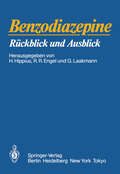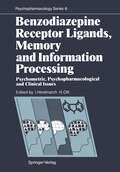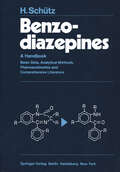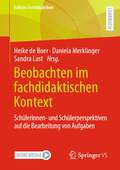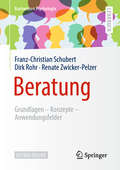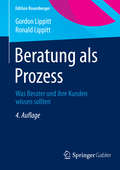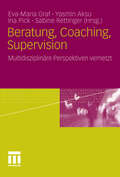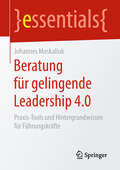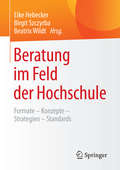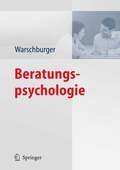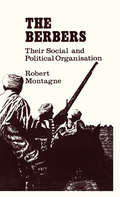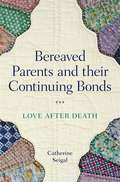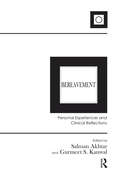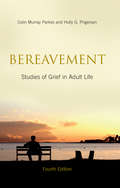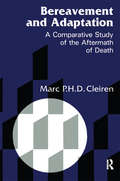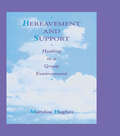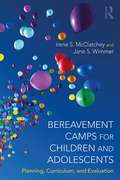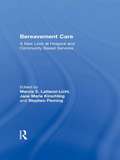- Table View
- List View
Benzodiazepine: Rückblick und Ausblick
by Hanns Hippius Rolf R. Engel Gregor LaakmannIn allen klinischen Disziplinen der Medizin werden Benzodiazepine therapeutisch eingesetzt. Diese Entwicklung war nicht vorauszusehen, als vor 25 Jahren das erste Benzodiazepin-Derivat (Chlordiazepoxid) als "Ataraktikum", als "Tran quilizer" in der Psychiatrie eingeführt wurde. Inzwischen gehören die zahlreichen Benzodiazepine und wirkungsähnliche, strukturverwandte Pharmaka weltweit zu den am häufigsten verordneten Arznei mitteln. Das ursprüngliche Indikationsgebiet der Benzodiazepine bei psychiatri schen Patienten - die sogenannte Anxiolyse - ist längst nur noch ein Teilbereich der vielfältigen Anwendungsmöglichkeiten für dieses Arzneimittel. In einigen Indikationsgebieten (z. B. als Schlafmittel) haben die Benzodiazepine inzwischen ältere Medikamente (z. B. Barbiturate) völlig zu Recht sehr weitgehend verdrängt. Das Urteil über Nutzen und Risiken der Benzodiazepine hat sich in den letzten Jahren immer wieder einmal geändert. Jetzt sind die Meinungen oft so kontrovers, daß Benzodiazepine im Widerstreit völlig unterschiedlicher Ansichten stehen. Das hängt damit zusammen, daß man aus verschiedenen Perspektiven zu durchaus divergierenden Ansichten kommen kann. So wird der in der Praxis tätige Arzt womöglich anders urteilen als der Kliniker; der Nervenarzt kann zu einem anderen Urteil kommen als die Ärzte anderer Fachdisziplinen; der Anästhesist, der Suchtexperte, der klinische Pharmakologe, der Schlafforscher, der Epileptologe, der Psychotherapeut und der Toxikologe haben oft weit voneinander abweichende, manchmal sogar völlig konträre Ansichten über die therapeutische Bedeutung der Benzodiazepine - über deren Nutzen und deren Risiko. Aber nicht nur die verschiedenen fachlichen Perspektiven können zu unter schiedlichen Ansichten führen; auch aus der Perspektive eines einzelnen Fachs haben sich innerhalb der vergangenen 25 Jahre immer wieder neue, sich durchaus wandelnde Einschätzungen der Benzodiazepine ergeben.
Benzodiazepine Receptor Ligands, Memory and Information Processing: Psychometric, Psychopharmacological and Clinical Issues (Psychopharmacology Series #6)
by Ian Hindmarch and Helmut OttThe following papers were presented at an international workshop on benzo diazepine receptor ligands, memory and information processing, held during the 15th CINP meeting in Puerto Rico in December 1986 and organised by the editors and T. Roth. This workshop was aimed at reviewing and reflecting on past experience with benzodiazepines, evaluating the current state of knowledge of the actions of psychotropic orugs (particularly benzodiazepines, fJ-carbolines and benzodiazepine antagonists), and laying a basis of interest and speculation for future research into the potential use of these drugs in disorders of memory and information processing. There is much published material regarding the theoretical underpinnings of what psychologists call "memory", and doubtless there will be several more libraries filled with theses on the topic before a consensus is reached as regards basic definitions or even meaningful distinctions between for example, "short" and "long"-term memory - everyone has his own particular theory. The qualitative and quantitative diversity of the different approaches might seem to present an insurmountable problem for the psychologist seeking a unified conceptual framework. In practice the various theories produce a plethora of pragmatic and experimental techniques for psychopharmacologists and clinicians to use when investigating drugs with putative amnestic or promnestic properties.
Benzodiazepines: A Handbook. Basic Data, Analytical Methods, Pharmacokinetics and Comprehensive Literature
by H. SchützTo comment at length on the importance of the benzodiazepines seems superfluous within the scope of this preface. No other class of active substances has experienced an even approximately compa rable advance in the past two decades. It is therefore not surprising that the formerly dominant barbiturates and bromocarbamides have had to give way in many fields to the benzodiazepines, which now rank first (Proudfoot and Park [1828]). Closely linked with the great therapeutic importance of the benzodia zepines are analytical problems. Detection and the determination of blood levels can be necessary under therapeutic aspects, for instance in working out optimally effective levels in the treatment of epileptic conditions ("drug monitoring"), but also in connection with questions at issue in toxicology and traffic medicine. A toxicological analysis can be subdivided into the following steps: Detection (identification including screening) Determination (e. g. blood, plasma or serum levels) Interpretation of the analytical results. This book is intended as a contribution to each of these chapters: The part "Analytical Data" (pp.I-122) gives a comprehensive collec tion of data, e.g. general and chromatographic data (TLC, GLC) as well as spectra (UV, IR, MS) of 19 commercial preparations, 23 important metabolites and 18 hydrolysis derivatives. Information about biotransformation and the possible formation of aminobenzo phenone derivatives is also given. The most important analytical methods are presented in an extensive review on pp.123-204 in order to make it possible to select the optimum method on the basis of the essential data.
Beobachten im fachdidaktischen Kontext: Schülerinnen- und Schülerperspektiven auf die Bearbeitung von Aufgaben (Edition Fachdidaktiken)
by Heike De Boer Daniela Merklinger Sandra LastIm Mittelpunkt dieses Bandes steht die videogestützte Beobachtung. Gefragt wird, wie sich Schüler*innen fachliche Aufgaben im Deutsch- und Sachunterricht aneignen. Zu allen Beiträgen liegen Videoszenen vor. Auf der Basis von Beobachtungsprotokollen werden Rekonstruktionen der Aufgabenbearbeitung vorgenommen. Fokussiert werden dabei nicht nur Mikroprozesse der Aufgabenbearbeitung, sondern auch die Perspektiven von Schüler*innen auf den fachlichen Lerngegenstand.
Beratung: Grundlagen – Konzepte – Anwendungsfelder (Basiswissen Psychologie)
by Franz-Christian Schubert Dirk Rohr Renate Zwicker-PelzerDieses Lehrbuch ist eine Einführung in die psychosoziale Beratung. Es vermittelt ein Verständnis von Beratung als einer Handlungsdisziplin, die sich nicht mehr als Subdisziplin verschiedener Fachgebiete versteht, sondern als ein eigenständiges, disziplinübergreifendes sowie wissenschaftlich fundiertes Denk- und Handlungskonzept. Dieses wird heute über spezifische Studiengänge an Hochschulen und Weiterbildungseinrichtungen vermittelt. – Als Lernende in diesen Einrichtungen erfahren Sie in dem Buch, wie sich Beratung vor dem Hintergrund etablierter Therapieschulen sowie lebensweltlicher und ressourcenorientierter Konzepte begründen kann.
Beratung als Prozess: Was Berater und ihre Kunden wissen sollten (Edition Rosenberger #0)
by Gordon Lippitt Ronald LippittKaum eine Tätigkeit erfordert so viel kritische Selbstreflexion wie die des Beratens. Dr. Gordon L. Lippitt, ehemals Professor für Behavioral Science an der School of Government and Business Administration, George Washington University, Vorsitzender der International Consultants Foundation, und Dr. Ronald Lippitt, emeritierter Professor für Soziologie und Psychologie an der University of Michigan, haben auf diesem Feld Pionierarbeit geleistet.Jeder Berater und jede Beraterin wird in diesem Buch eine Vielzahl von Strategien und Beratungstechniken kennen lernen, mit denen sich das eigene professionelle Verhaltensrepertoire gewinnbringend erweitern lässt. Zahlreiche Beispiele zeigen Beratung in Aktion und machen dieses Buch zu einem reichen Erfahrungsschatz und zum unverzichtbaren Standardwerk.
Beratung, Coaching, Supervision: Multidisziplinäre Perspektiven vernetzt
by Eva-Maria Graf Yasmin Aksu Ina Pick Sabine RettingerDem Ruf nach fundierter Forschung zu Beratung, Coaching und Supervision folgend, sind in diesem Band einige der neuesten Ergebnisse zur Beratungsforschung aus der Perspektive verschiedener Disziplinen – beispielsweise der Sprachwissenschaft, der Sozialwissenschaften, der Psychologie und der Erziehungswissenschaft – sowie Impulse aus der Praxis vereint. Auf dem Weg zu einer Forschung, in der die Disziplinen Ergebnisse nicht mehr nebeneinander, sondern miteinander generieren, wird zwischen den einzelnen Beiträgen ein Netz gespannt und so gezeigt, wie reichhaltig bereits jetzt die Grundlage für die gemeinsame Arbeit ist. Diese Vernetzung soll sowohl Forscher/innen, die sich mit den Formaten Beratung, Coaching und Supervision beschäftigen, wie auch Vertreter/innen der Praxis Anregungen geben und zu einer gemeinsamen Arbeit inspirieren. Denn interdisziplinäre Forschung kann nur in einem echten Austausch auf Augenhöhe fruchtbar sein.
Beratung für gelingende Leadership 4.0: Praxis-Tools und Hintergrundwissen für Führungskräfte (essentials)
by Johannes MoskaliukJohannes Moskaliuk gibt in diesem essential einen fundierten Einblick in aktuelle Diskurse zum Thema Leadership 4.0 und zeigt auf, welchen Anforderungen Führungskräfte sich wirklich stellen müssen. Dabei berücksichtigt er wissenschaftliche Erkenntnisse aus der Motivations- und Kognitionspsychologie und deren Konsequenzen für Führung und Kommunikation. Es werden praxiserprobte und wirksame Methoden vorgestellt, wie Leadership 4.0 gelingen kann. Außerdem wird aufgezeigt, dass Digital Leadership mehr ist, als das Nutzen digitaler Technologien für Kommunikation und Kooperation. In jedem Kapitel findet sich ein konkretes Führungswerkzeug, das Coaches, Berater oder Führungskräfte direkt einsetzen können.
Beratung im Feld der Hochschule: Formate – Konzepte – Strategien – Standards
by Johannes WildtDas Buch zeigt einen repräsentativen Querschnitt von professionellen und semiprofessionellen Beratungsangeboten für Adressatengruppen an Hochschulen und führt in den aktuellen Diskurs über Professionalisierung und Qualitätsstandards von Beratung ein. Formate wie Fachberatung, Coaching, Supervision und Mentoring werden berücksichtigt. Für die Qualität von Beratung und Beratungsangeboten, Programmgestaltung und Qualitätsmanagement sind New Professionals in einer Third Sphere zwischen Wissenschaft und Administration verantwortlich. An verschiedenen Konzepten und einschlägigen Programmen für Beratung und Weiterbildung werden zentrale hochschuldidaktische Anliegen und damit verknüpfte Aufgaben der Personalentwicklung deutlich.
Beratungspsychologie
by Petra WarschburgerOb Ehe- oder Laufbahnberatung – der Wunsch nach Beratung scheint kennzeichnend für unsere Gesellschaft zu sein. Es ist kein spezifisch psychologisches Arbeitsgebiet, aber Psychologen beraten in den verschiedensten Feldern. Das Buch konzentriert sich auf die klassischen Anwendungsbereiche der Psychologie und stellt den Beratungsprozess ausführlich dar. Dabei wird der Problemlösungsprozess als Metakonzept der Beratung gesehen. Als neuere Ansätze werden das transtheoretische Modell, Motivational Interviewing und die mediengestützte Beratung diskutiert.
The Berbers: Their Social and Political Organisation
by Robert MontagneFrance entered the North African world in 1830. Its overt political role there ended in 1962. The interpenetration of cultures and languages which resulted from the colonial conquest has not ended yet. No doubt a time will come when an intellectual balance sheet of this epoch comes to be drawn up. When this is done, Robert Montagne’s name will head the list of those Frenchmen who have made a study of Berber society. The brilliance of his ideas, the thoroughness and perceptiveness of his documentation, the range of his historical and comparative vision, and (a trait not always found in scholarly writing on North Africa) the simplicity and vigour of his style, all help to make plain that we have here a social thinker and observer of the very first rank, and one who deserves to be far better known outside the French-speaking world than he is at present.
The Berbers: Their Social and Political Organisation (Routledge Revivals Ser.)
by Robert MontagneFrance entered the North African world in 1830. Its overt political role there ended in 1962. The interpenetration of cultures and languages which resulted from the colonial conquest has not ended yet. No doubt a time will come when an intellectual balance sheet of this epoch comes to be drawn up. When this is done, Robert Montagne’s name will head the list of those Frenchmen who have made a study of Berber society. The brilliance of his ideas, the thoroughness and perceptiveness of his documentation, the range of his historical and comparative vision, and (a trait not always found in scholarly writing on North Africa) the simplicity and vigour of his style, all help to make plain that we have here a social thinker and observer of the very first rank, and one who deserves to be far better known outside the French-speaking world than he is at present.
Bereaved Parents and their Continuing Bonds: Love after Death
by Catherine SeigalFor bereaved parents the development of a continuing bond with the child who has died is a key element in their grieving and in how they manage the future. Using her experience of working in a children's hospital as a counsellor with bereaved parents, Catherine Seigal looks at how continuing bonds are formed, what facilitates and sustains them and what can undermine them. She reflects on what she learned about the counsellor's role supporting parents in extremely distressing situations. Using the words and experiences of bereaved parents, and drawing on current theories of continuing bonds, the book is relevant to both professionals and parents. It covers important subjects such as the benefits of a therapeutic group for bereaved parents, the challenges for parents when another child is born, the important role of siblings in keeping the bonds alive and how it is for parents whose child dies before birth or in early infancy. The book uses theory lightly but relevantly and places it into the heart of the lived experience. It offers anyone working with bereaved parents insight into the many and varied ways grief is experienced and expressed and what can be helpful and unhelpful. And it offers bereaved parents the opportunity to share other parents' experiences, to understand a little more about their own feelings and to know they are not alone, providing an original and valuable guide to continuing love after death.
Bereaved Parents and their Continuing Bonds: Love after Death (PDF)
by Catherine SeigalFor bereaved parents the development of a continuing bond with the child who has died is a key element in their grieving and in how they manage the future. Using her experience of working in a children's hospital as a counsellor with bereaved parents, Catherine Seigal looks at how continuing bonds are formed, what facilitates and sustains them and what can undermine them. She reflects on what she learned about the counsellor's role supporting parents in extremely distressing situations. Using the words and experiences of bereaved parents, and drawing on current theories of continuing bonds, the book is relevant to both professionals and parents. It covers important subjects such as the benefits of a therapeutic group for bereaved parents, the challenges for parents when another child is born, the important role of siblings in keeping the bonds alive and how it is for parents whose child dies before birth or in early infancy. The book uses theory lightly but relevantly and places it into the heart of the lived experience. It offers anyone working with bereaved parents insight into the many and varied ways grief is experienced and expressed and what can be helpful and unhelpful. And it offers bereaved parents the opportunity to share other parents' experiences, to understand a little more about their own feelings and to know they are not alone, providing an original and valuable guide to continuing love after death.
Bereavement: Personal Experiences and Clinical Reflections
by Salman AkhtarThis is a book about death, loss, grief and mourning, but with an unusual twist. It is different in that it explores specific kinds of deaths encountered within families and households, rather than general concepts of mourning. It is even more unusual because here six psychoanalysts reveal how they have suffered, processed, and survived losses in their own lives; at the same time bringing clinical and theoretical perspectives of various psychoanalytic schools to bear on their own, as well as others', experiences. The narratives in this book use the power of subjective experience, as described by psychoanalysts themselves, to understand, contextualize, and extend existing clinical approaches. Each chapter addresses the death of a different loved one. The losses discussed include death of a mother, death of a father, death of a sibling, death of a spouse, death of a child, and death of a pet (recognizing the deep significance of pets in human households).
Bereavement: Personal Experiences and Clinical Reflections
by Salman AkhtarThis is a book about death, loss, grief and mourning, but with an unusual twist. It is different in that it explores specific kinds of deaths encountered within families and households, rather than general concepts of mourning. It is even more unusual because here six psychoanalysts reveal how they have suffered, processed, and survived losses in their own lives; at the same time bringing clinical and theoretical perspectives of various psychoanalytic schools to bear on their own, as well as others', experiences. The narratives in this book use the power of subjective experience, as described by psychoanalysts themselves, to understand, contextualize, and extend existing clinical approaches. Each chapter addresses the death of a different loved one. The losses discussed include death of a mother, death of a father, death of a sibling, death of a spouse, death of a child, and death of a pet (recognizing the deep significance of pets in human households).
Bereavement: Studies of Grief in Adult Life, Fourth Edition (Pelican Ser.)
by Colin Murray Parkes Holly G. PrigersonThe loss of a loved one is one of the most painful experiences that most of us will ever have to face in our lives. This book recognises that there is no single solution to the problems of bereavement but that an understanding of grief can help the bereaved to realise that they are not alone in their experience. Long recognised as the most authoritative work of its kind, this new edition has been revised and extended to take into account recent research findings on both sides of the Atlantic. Parkes and Prigerson include additional information about the different circumstances of bereavement including traumatic losses, disasters, and complicated grief, as well as providing details on how social, religious, and cultural influences determine how we grieve. Bereavement provides guidance on preparing for the loss of a loved one, and coping after they have gone. It also discusses how to identify the minority in whom bereavement may lead to impairment of physical and/or mental health and how to ensure they get the help they need. This classic text will continue to be of value to the bereaved themselves, as well as the professionals and friends who seek to help and understand them.
Bereavement: Studies of Grief in Adult Life, Fourth Edition
by Colin Murray Parkes Holly G. PrigersonThe loss of a loved one is one of the most painful experiences that most of us will ever have to face in our lives. This book recognises that there is no single solution to the problems of bereavement but that an understanding of grief can help the bereaved to realise that they are not alone in their experience. Long recognised as the most authoritative work of its kind, this new edition has been revised and extended to take into account recent research findings on both sides of the Atlantic. Parkes and Prigerson include additional information about the different circumstances of bereavement including traumatic losses, disasters, and complicated grief, as well as providing details on how social, religious, and cultural influences determine how we grieve. Bereavement provides guidance on preparing for the loss of a loved one, and coping after they have gone. It also discusses how to identify the minority in whom bereavement may lead to impairment of physical and/or mental health and how to ensure they get the help they need. This classic text will continue to be of value to the bereaved themselves, as well as the professionals and friends who seek to help and understand them.
Bereavement and Adaptation: A Comparative Study of the Aftermath of Death (Series in Death, Dying, and Bereavement)
by Marc CleirenThis book offers a critical review of the main psychological theories on adaptation after loss followed by an overview of the results of the empirical research on bereavement. It also reflects on the results of the Leiden Bereavement Study, which compares the consequences of death.
Bereavement and Adaptation: A Comparative Study of the Aftermath of Death (Series in Death, Dying, and Bereavement)
by Marc CleirenThis book offers a critical review of the main psychological theories on adaptation after loss followed by an overview of the results of the empirical research on bereavement. It also reflects on the results of the Leiden Bereavement Study, which compares the consequences of death.
Bereavement and Support: Healing in a Group Environment (Series in Death, Dying, and Bereavement)
by Marylou HughesIn the early 1970s bereavement support groups were almost unknown. However, the obvious benefits of the group process for recovery - the mutual support and understanding that helps mourners to a better outlook - has created a demand for people who can organise and facilitate these groups. Addressing the basis and need for support groups for the bereaved, this book presents a theoretical overview, examines benefits and variety of support groups structured and unstructural, special populations and specifics for initiating, organising and running them, such as publicity. It differs from other treatments in that theory and practice are moulded into a how-to approach, with all procedures presented equally for the widest range of choices. Also included is a comprehensive book bibliography for adults, children, children's helpers and parents. This text is intended to be of use as a resource for professionals in the field of thanatology, including psychologists, psychiatrists, gerontologists, therapists, group counsellors, hospice workers, educators, funeral home directors, home health employees, hospital staff and volunteer organisations that work with survivors.
Bereavement and Support: Healing in a Group Environment (Series in Death, Dying, and Bereavement)
by Marylou HughesIn the early 1970s bereavement support groups were almost unknown. However, the obvious benefits of the group process for recovery - the mutual support and understanding that helps mourners to a better outlook - has created a demand for people who can organise and facilitate these groups. Addressing the basis and need for support groups for the bereaved, this book presents a theoretical overview, examines benefits and variety of support groups structured and unstructural, special populations and specifics for initiating, organising and running them, such as publicity. It differs from other treatments in that theory and practice are moulded into a how-to approach, with all procedures presented equally for the widest range of choices. Also included is a comprehensive book bibliography for adults, children, children's helpers and parents. This text is intended to be of use as a resource for professionals in the field of thanatology, including psychologists, psychiatrists, gerontologists, therapists, group counsellors, hospice workers, educators, funeral home directors, home health employees, hospital staff and volunteer organisations that work with survivors.
Bereavement Camps for Children and Adolescents: Planning, Curriculum, and Evaluation
by Irene Searles McClatchey Jane S. WimmerBereavement Camps for Children and Adolescents is the first book to describe in detail how to create bereavement camps for children and adolescents. It is a comprehensive how-to guide, offering practical advice on planning, curriculum building, and evaluation. Readers will find a step-by-step plan for building a non-profit organization, including board development and fundraising, such as grant writing, soliciting businesses, and holding special events, as well as valuable information on nonprofit management and volunteer recruitment. The appendices include a variety of sample forms, letters, and more.
Bereavement Camps for Children and Adolescents: Planning, Curriculum, and Evaluation
by Irene Searles McClatchey Jane S. WimmerBereavement Camps for Children and Adolescents is the first book to describe in detail how to create bereavement camps for children and adolescents. It is a comprehensive how-to guide, offering practical advice on planning, curriculum building, and evaluation. Readers will find a step-by-step plan for building a non-profit organization, including board development and fundraising, such as grant writing, soliciting businesses, and holding special events, as well as valuable information on nonprofit management and volunteer recruitment. The appendices include a variety of sample forms, letters, and more.
Bereavement Care: A New Look at Hospice and Community Based Services
by Jane Marie Kirschling Marcia E Lattanzi Stephen FlemingHere is a comprehensive, interdisciplinary look at current bereavement care practices and key concerns of care providers. Covering a broad spectrum of topics, interests, and perspectives from divergent disciplines and clinical experiences, the contributing authors explore theories and constructs that can clarify and be useful in the provision of bereavement services.Bereavement Care: A New Look at Hospice and Community Based Services addresses important issues related to the delivery of bereavement care and services. Chapters focusing on clinical concerns examine ways to distinguish grief from depression and the use of Jung’s theory to expand an understanding of the grief process. Others explore options for community-based group interventions and the role of the volunteer in the provision of hospice bereavement services. Chapters with a research focus highlight effective assessment tools, the applicability of Bugen’s model, and the practice and problems involved in hospice bereavement services.This rich and compassionate volume will be helpful to mental health professionals, social workers, chaplains, nursing personnel, and volunteers who work with or provide services to bereaved persons and families.
